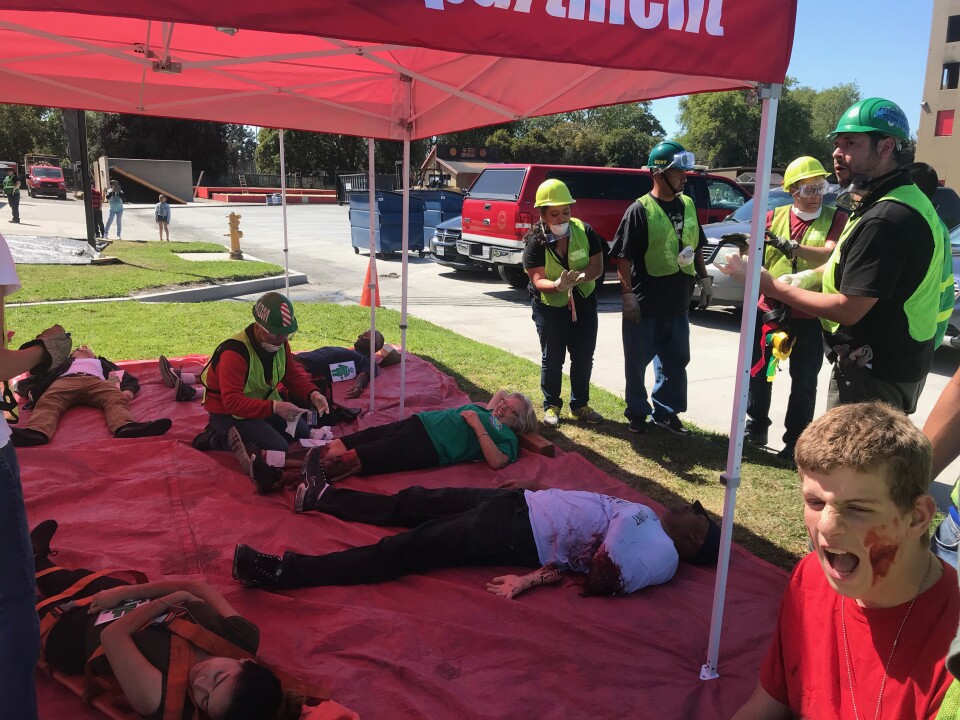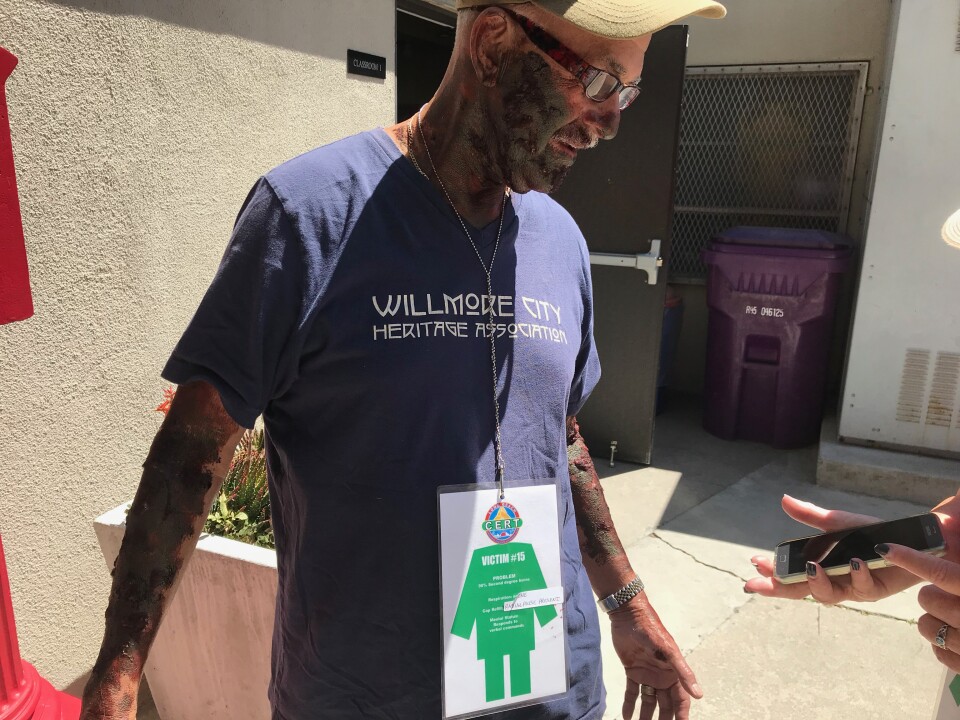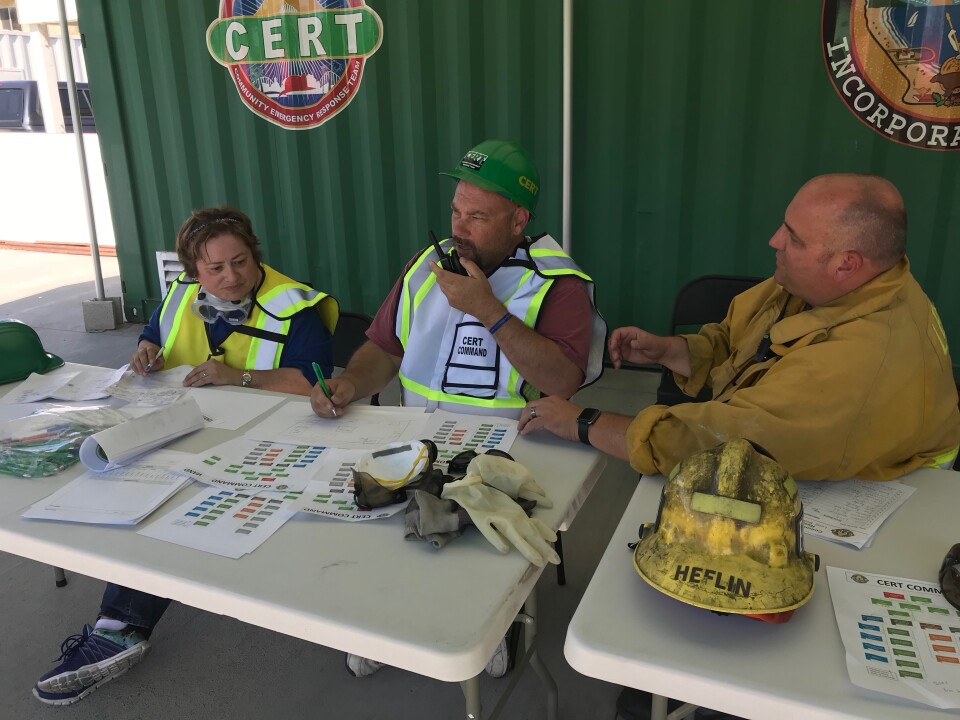What comes next for the Central American migrant caravan, a gondola to Dodger Stadium is not an original idea, testing out the Tesla Model 3.
'Caravan' of migrants from Central America prepares to enter the US
A "caravan" of migrants that has been making its way North from Central America began arriving at a shelter in Tijuana this week with hopes of entering the U.S. as early as this weekend.
Reuters correspondent Delphine Schrank described the scene Thursday:
A first busload arrived Tuesday — another three more in the night. People are tired, but they're happy to be near the U.S. border. Some are a little anxious. Some have poured out of these buses with whatever bags they had after exactly a month-long journey through Mexico. They've been living in all kinds of strange conditions — sometimes outdoors. Yesterday they were in tents in one shelter.
Schrank says the caravan, at its peak, had over 1,000 people. Presently about 600 migrants remain. The group is primarily made up of men, women, and children from El Salvador, Guatemala, and Honduras — all areas experiencing unrest including violence and economic hardship. She adds that this year's group has more children than in years prior.
The individual stories they're telling me in great detail are stories of lethal threats that adults face, or a sense of political persecution, or just economic conditions that are so bad that they feel the need to leave now.
The Reuters correspondent notes the 2,000-mile trip has been perilous. Many attempt to hop on a train that runs through Mexico. Severe injuries are common. But she adds that many of the women have a particularly dangerous journey.
Regularly, women are raped. Regularly, all migrants who travel this route are subject to extortion, assault, and run-ins with authorities if they don't have the documentation they need. In this instance, that's the founding reason for moving together as a group. The women and children that have been in this group feel much safer.
While not all of the migrants will try to enter the United States, Schrank says at least 200 plan to seek asylum Sunday. They face long odds.
A lot of them have cases that may be rejected. There's a very high rejection rate for people particularly from Honduras and El Salvador. Like every moment of this journey, it's been spontaneous and improvised, but this day, they plan to be together.
(Answers have been edited for clarity and brevity.)
Could a gondola to Dodger Stadium solve traffic woes? LA's mayor is pitching it
Dodger fans heading to Chavez Ravine have long dealt with the traffic nightmare that accompanies each home game. But a new plan being pitched could help Angelenos rise above the congestion.
On Thursday morning, Los Angeles Mayor Eric Garcetti gave a presentation at the weekly Metro board meeting, proposing a gondola lift from Union Station to Dodger Stadium.
The Aerial Rapid Transit (ART) project, proposed by Aerial Rapid Transit Technologies LLC, would "transport Dodger fans, community members, and visitors from Downtown Los Angeles to the Dodger Stadium property in minutes," the company said in a release.
The company said the project will be a privately funded, "zero-emission transit line."

The L.A. Times reported Thursday that a familiar face is funding the company behind the project: former Dodgers owner Frank McCourt.
The company is seeking cooperation from Metro to help plot out a route for the gondola line and start a public environmental review.
If all goes according to plan, the gondola lift could be open in 2022.
So how feasible is something like this? The proposal promises to get riders from Union to Dodgers stadium in about five minutes.
"If I take the sketch figures seriously," said USC Engineering professor Jim Moore, "it's about 5,000 persons per direction, per hour. That's about two and a half traffic lanes per direction, per hour. So that's basically good news."
The added bonus is this isn't brand new technology, it's been implemented a number of different places. "It's certainly worth examining," said Moore, "and I won't dismiss it."
Moore explains that while the proposed system may feel out of the ordinary here in Los Angeles, on paper, it doesn't seem difficult to achieve:
We've built gondola systems in some very challenging areas. They show up in mountainous areas where there are big changes in elevation, smaller version service ski lifts. So, you can build a system like this just about any place you really need it. It's a lower imprint activity than some other transportation options. So it might well be possible to exercise this option where others would be more challenging.
And it's not an original idea. Back in 1990, the Los Angeles County Transportation Commission released the Dodger Stadium Transit Access Study, which explored ideas like pedestrian escalators, a shuttle bus service — and a gondola.

When the big one hits, are you ready?
Los Angeles is one of the most disaster prone cities in the world, vulnerable to earthquakes, fires and many other disasters. So it shouldn't come as a surprise that Community Emergency Response Training, or CERT, started here.
Designed to teach regular people how to be first responders, it's now a national program made available through the Federal Emergency Management Agency, which recognized the CERT program in Long Beach last year for outstanding community preparedness.
Over the weekend, CERT Long Beach ran a mock disaster drill, simulating a 7.6 earthquake in L.A. County. It's the earthquake everyone has been dreading. You check yourself and you’re ok, so you wander into the street. Cars are flipped over and fires are smoldering. You start to hear people screaming.
You see a six-story building that looks partially destroyed, black from fire. You walk into the building and hear a little boy screaming for help, his voice echoing in the stairwell.
Then you see three men with hard hats, protective glasses and neon green vests. They yell.
“Long Beach CERT. Anyone in here?”
So this isn’t actually the big one. It’s the Community Emergency Response Training drill (CERT) with the Long Beach Fire Department. But for many of the participants it feels really real.

Three emergency response trainees have found a teenage boy who's pretending that his right abdomen is impaled by a stick. His injuries look pretty real. The trainees are learning how to assess victims, to properly transport them and perform basic triage. In this case, they lift the boy onto a chair and then down the stairs.

“This event is really designed to push them and make them work together as a team: to come together to provide first aid, search and rescue and medical and fire suppression,” says Jake Heflin, CERT’s program manager and a firefighter with the Long Beach Fire Department for 18 years.
The training drill is filled with victims wandering around screaming for help and others hidden under cars or machinery. It’s chaotic, just like it would be in a real disaster, especially at the makeshift triage center.


There's a guy with third degree burns all over his body and others with glass in their arms and blood all over them. These injuries aren’t real; they’re the work of moulage artists who apply fake injuries. Heflin says moulage artists and volunteer victims who act out their parts are very important to the drill because it gives participants a sense of realism and urgency.

Today's drill is the culmination of two full days of training. It's based on real life estimates of a 7.8 magnitude earthquake hitting Southern California. A disaster like that would kill around 2,000 people and injure another 50,000. It would also cause billions of dollars of damage, destroying freeways and leaving the region without gas, electricity and water. Earthquakes of this magnitude have historically occurred every 150 years in the region. It's been 300 since the last one. Long Beach CERT is working to make sure its community will be ready.

The training is designed to give ordinary folks the tools to save lives. Heflin says there are 124 fire fighters on duty on any given day in Long Beach. The city has half a million residents. That's roughly one firefighter for every 5,000 people. He says when (not if) disaster hits, the fire department will absolutely be overwhelmed

“We will rely on volunteers that are trained in CERT, other volunteers that are passionate about contributing to the community to support and assist those in need -- to be able to rally, to be able come together do the greatest good for the greatest number of people in the shortest amount of time,” Heflin says.

'The greatest good for the greatest number of people’ is CERT's motto. In an emergency, fire fighters will get a lot of calls for help and they will go where the damage is most severe and the greatest amount of people need help -- a collapsed school with 100 trapped kids, for example, instead of a house with five people trapped. So who’s going to help those five people?

CERT is the fire department's 'force multiplier.' It's their way of training the community to be able to take care of itself in a disaster. After the drill, many participants say they feel empowered.
“It makes me feel like, okay instead of fear being my first instinct, react and respond and see, okay what's our plan? Plan, not fear, [that’s a] big difference," says Danica Potts.

During the drill she successfully put out a fire, saved two people’s lives and applied emergency medical aid to someone with broken ribs. Two days ago, Potts was just an ordinary community member with no idea how to preform these tasks.

The skills participants learn will help not only in a disaster but in everyday situations like putting out a fire—before it engulfs a home, then a street and potentially a neighborhood—stopping disaster before it starts. One study Heflin sited said that for every $1 spent on preparation, we save $6 in response recovery money.

In 2017, Long Beach CERT won FEMA’s national award for the Outstanding Community Emergency Response Team Initiatives award. More than 1,000 people have graduated from CERT programs in Long Beach since they started. You just never know when the big one's coming, but what we do know is that luck favors the prepared.
As LA's homeless crisis persists, should 'hostile urbanism' be reexamined?
The Vermont triangle is a street median that doubles as a mini park at the intersection of Vermont Avenue and Hollywood Boulevard in Los Feliz. Since being redesigned to create a gateway to the area's shopping district, it's been over run with homeless. Now city officials are proposing that planters be added to the triangle in an effort to deter homeless people from sleeping there and pitching tents. Urban designer Amber Hawkes, with Here L.A., explains:
What is hostile architecture?
It's any time something in the urban realm is designed to be unfriendly to humans, so spikes, railings on a bench so you can’t lie down, designing a really wide roadway that’s unpleasant to walk next to. A lot of people think of it as deterring a certain population from being in a place that designers or business owners don’t want them to be.
How hostile design is used in L.A.
In L.A., we’ve prioritized the vehicle in the design of our city around vehicles, so a lot of our hostile urbanism is surrounding areas where we are grappling with ways we prioritize the vehicle through design: freeway underpasses, residual median spaces between roadways. Any leftover space that a human doesn’t feel comfortable to inhabit.
Hostile designs are often used to deter homeless
I remember one from a couple years ago along Beaudry. It was a chain link fence, almost a cage around the sidewalk. It was not installed by the city, but it was indicative of how we as a community are grappling with the issue of homelessness in our city. There was a long homeless encampment along Beaudry and the fence was installed apparently to move folks along. A lot of places we see large planters being put in to not give them enough room to set up a tent.
Putting planters in the Vermont triangle
A lot of solutions that are hostile in nature look at enclosure — closing in, closing off, restricting. Restricting access for one particular population makes it unfriendly for everyone to be in that space. At the same time, these issues are pervasive. Business owners are grappling with issues like safety, so there is no small solution here.
City agencies, business owners and homeowners all use hostile architecture
You’ll see guerrilla techniques of people trying to deal with the issue right in front of their business or home. You'll see city agencies using these techniques. Designers. Pretty much everybody. It’s hard to encourage people not to use them when money, resources, the mentality isn’t there to acknowledge that we can’t cut corners in this way when it comes to designing solutions.
Will there be more hostile architecture as homelessness worsens?
I’m an optimist, so I think we’re moving in the right direction. I think we’ve realized we cannot design cities in the way we have before. You see that in mayor’s Great Streets initiative. A lot of designers are not doing design as usual. These forms are more patch-up jobs than long-term solutions. We want to see positive urbanism. We want to see people using our space and these things do just the opposite.
After 2 long years, our reporter finally gets her Tesla Model 3
The Tesla Model 3 has been in the news pretty much nonstop since it was first unveiled two years ago. Since then, more than half a million people have put down deposits for the company's $35,000 sedan for the masses. Including me. Few people have received their cars due to massive production delays at the Tesla factory, but I finally got mine April 20, more than two years after putting down my $1,000 deposit for the car sight unseen.
Why I bought the Tesla Model 3 before seeing it or driving it
Simple. I loved the Model S. When I reviewed the S for the Orange County Register back in 2013, I was leasing a Nissan Leaf. Driving the Model S felt like a tryst -- like I was cheating on my ball and chain. Simply put, the Model S was one of the most remarkable cars I'd ever driven, so when I went to Tesla's unveiling of the Model 3 in March 2016, I succumbed. It was only $1,000 to get in line. I could always get it back if I changed my mind.
First contact
After receiving a confirmation email that Tesla received my deposit, I didn't hear from Tesla about my car for 18 months. Sure, I received the occasional marketing email, but it wasn't until November 1, 2017, that I got an update on delivery timing for my Model 3 saying I might get the car as early as December. Well, that didn't happen. The next time I logged onto my Tesla account, my delivery date had been bumped to a new window -- between January and March of this year, then between April and June. And then, on March 22, I got an email saying (finally) my Model 3 was ready to order. I should note that the reason I'm able to get my car now is because I'm getting the more expensive first production version, which starts at $49,000. The $35,000 version won't be available until later this year.
The process
Easy. Almost everything was done online, from placing my deposit to configuring the exact version of the car I wanted, arranging financing, making my down payment and coordinating a trade-in. I had two phone calls from a sales associate nudging me to finish the digital paperwork and letting me know the exact date and time I could pick up my car, but the one and only time I had any human contact during the process was when I picked up the car at the delivery center in Marina Del Rey.
The delivery center
It's nondescript. If it weren't for the red Tesla flags fluttering in the wind outside its entrance, you'd never suspect. The Teslas are parked inside, on carpet -- past an espresso bar that serves a variety of coffee drinks brewed with a special Supercharger blend. I was introduced to my personal sales associate Roberto, and he pulled back a curtain to escort me to my shiny red Model 3, which was parked with about 30 other cars -- most of them black, gray and white. He walked me through the car's basics, including the Tesla app that serves as the 3's key, and its basic features. A half hour later, I signed the purchase agreement and registration, and then I was off.
So, how is it?
Considering I was getting major cold feet about the car a few weeks ago, after reading reports about shoddy build quality and reviews that criticized its do-everything tablet-like screen, I LOVE it. It's a lot more money than I wanted to spend -- total cost including taxes and registration came out to about $56,000 -- but it's super fun to drive, extremely quick off the line, quiet, great handling. I hope I continue to love it, because for how much it's costing, I'll need to keep it for the next several years. The screen is way more intuitive than I thought it would be. And that stereo! I forgot how much I love listening to music while driving on a sound system that sounds like God is my DJ. With the Model 3, I may not get free supercharging, but the Tesla music library is a gem.




